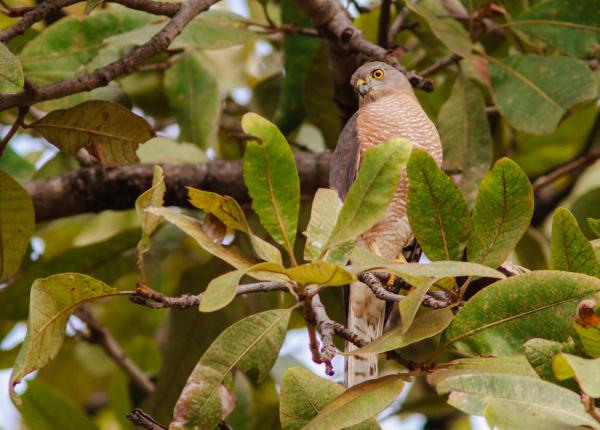Did You Know?
- The name, Shikra has its origins in the Urdu word Shikari and the Hindi word Shikaaree, both of which mean "hunter."
- The Shikra is known by several other common names including Ceylon Shikra, Indian Sparrowhawk, Little Banded Goshawk, Little Banded Sparrowhawk, and Shikra Goshawk.
- The Shikra has been a popular bird used in the sport of falconry
How The Peregrine Fund is Helping
Though The Peregrine Fund doesn't work directly with Shikras, our efforts in scientific research, habitat conservation, education, and community development help conserve raptors around the world. We also supply literature to researchers from our avian research library, which helps scientists the world over gather and share important information on raptor conservation.
Where They Live
The Shikra has a relatively wide range and is found across much of the Asian and African continents. It can be found in a long list over of 60 different countries including Angola, Afghanistan, Chad, Nepal, Sri Lanka, Cambodia,Eritrea, Ghana, Iran, China, Kuwait, Liberia, Mozambique, Nigeria, Rwanda, Saudi Arabia, Somalia, South Africa, Yemen, and Zimbabwe.
This stunning raptor occurs in a variety of habitats, including savanna, patchy scrub, dry and moist woodlands, dense and degraded forest, riparian forests, exotic tree plantations, towns, gardens, and cultivated areas.
What They Do
The Shikra is a small bird of prey, with a long, barred tail and powerful wings. The Shikra has a light breast and underbelly marked with thin reddish barring. Males and females differ slightly in their coloration. Most notably, male Shikras have deep red eyes, while females have more of an orange/yellow iris.
The Shikra is known for being a tenacious hunter!
Why They Need our Help
The Shikra is currently classified as a species of Least Concern. Thankfully, it isn't facing major threats across its range. However, this doesn't mean that the Shikra is in the clear, either. Habitat degradation is occurring through parts of its range, mainly due to harvesting of wood, and overgrazing by livestock. The use of insecticides in some areas might also harm this species. Other threats include electrocution on power lines, though this is probably less common.
What They Eat
The Shikra has an amazingly varied diet. It feeds on everything from lizards to frogs to large insects, termites, small birds and mammals, including rodents. It has been documented taking young birds from their nests, including nests of weavers, Bronze Mannikin, and Gorgeous Bush Shrike.
As you may have guessed, the Shikra must employ a number of different hunting strategies if it is going to be successful at catching all these different types of prey. It often takes birds near the ground after a dive from a concealed perch, or it will ambush birds and fly them down. It will also snatch prey from tree trunks and foliage, or in flight.
Nests, Eggs, and Young
The Shikra builds a relatively small nest made of sticks, often placed in the high fork of a woodland or exotic tree, such as eucalyptus. In Indonesia, several pairs were seen using coconut trees as nesting spots. Old magpie nests are also used by some pairs.
Both the male and the female will work together to construct their nest. However, it has been reported that the female will do about twice as much of the work as the male. When the time is right, the female will lay her eggs - usually between 2 and 4. She will do the majority of the incubation in the early nesting stages, but as time moves on, the male will assist more and more in making sure the eggs remain warm and safe. Eggs must be incubated for approximately 3 weeks!
Apart from the help the male gives the female during incubation, he has another very important job. He is responsible for make sure the female has enough to eat! He needs to hunt for himself and for her and, after the young hatch, he will need to catch enough prey to feed his growing family.
While the male brings the food, the female is the one who most often feeds the young. She does this by tearing off tiny pieces of food with her beak. She then lowers her beak to her hungry nestlings. They eagerly take the food she offers. The nestling will develop quickly and after a little over a month after hatching they will fly from the nest for the first time.
The Shikra and the World Center for Birds of Prey
The World Center for Birds of Prey offers fun ways to learn about raptors. The visitor center has interactive displays, tours, interesting videos and a children's room with activities from coloring sheets to quizzes to costumes and a touch table for the curious mind. Knowledgeable staff and volunteers are on hand to answer any questions you may have about Shikras or any other bird of prey.
References:
BILDSTEIN, K., Shikra Accipiter badius breeding in Armenia.
BirdLife International 2019. Accipiter badius (amended version of 2016 assessment). The IUCN Red List of Threatened Species 2019: e.T22695490A155445348. https://dx.doi.org/10.2305/IUCN.UK.2016-3.RLTS.T22695490A155445348.en
Kankane, PL (1996). "Strange death of a shikra". J. Bombay Nat. Hist. Soc. 96: 140–141.
Kemp, A. C. and G. M. Kirwan (2020). Shikra (Accipiter badius), version 1.0. In Birds of the World (J. del Hoyo, A. Elliott, J. Sargatal, D. A. Christie, and E. de Juana, Editors). Cornell Lab of Ornithology, Ithaca, NY, USA. https://doi.org/10.2173/bow.shikra1.01
Nurza, A., Mulyawati, D., Jaya, R.L., Sanir, T.M. and Noske, R.A., 2011. First breeding records of Shikra Accipiter badius in Indonesia. Kukila, 14, pp.54-58.









